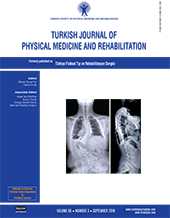Evaluation of balance in young adults with idiopathic scoliosis
2 Department of Physical Medicine and Rehabilitation, Tatvan State Hospital, Bitlis, Turkey DOI : 10.5606/tftrd.2019.2825 Objectives: This study aims to evaluate the relation of scoliosis with coronal and sagittal balance parameters and the effect of postural balancing in young adults with idiopathic scoliosis.
Patients and methods: Between April 2017 and June 2017, a total of 24 patients (7 males, 24 females; mean age 20.3±2 years; range 17 to 24) who were diagnosed with scoliosis and 65 age- and sex-matched healthy controls (20 males, 45 females; mean age 20.3±1.6 years; range 19 to 25) were included in the study. The Cobb angle, sagittal balance, coronal balance, and truncal shift were measured with radiographs in the patient group. The Biodex Balance System (BBS) was used to assess the general stability index, anteriorposterior and medial-lateral stability index, and fall risk.
Results: All balance parameters were significantly worse in the patient group than in the control group (p<0.05). The static balance was mostly associated with sagittal balance, followed by coronal balance. In the patients with left scoliosis, sagittal balance was 93% negative and 67% of the patients gave their weight to the back. Coronal balance was negative in 60% of the patients and 93.3% of the patients were weighted to the right side. In 89% of the patients with right scoliosis, sagittal balance was negative and 89% of the patients gave their weight to the back. Coronal balance was 44% neutral and 78% of the patients gave their weight to the right side.
Conclusion: In patients with scoliosis, the static balance is worse than healthy individuals. Static balance is mostly related to sagittal balance and also to coronal balance. While the coronal balance tends to be in the direction of the curve, both right and left scoliosis give more weight to the right.
Keywords : Balance, coronal, mature, sagittal, scoliosis

















